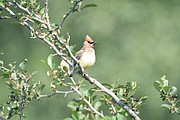Cedar waxwings: A sleek and dapper looking bird!
Don Bartling Contributing Writer | Hagadone News Network | UPDATED 6 years, 4 months AGO
Cedar waxwings are one of my favorite birds. From a distance, they look like garden-variety little brown birds. But a closer look reveals the striking crown and beautiful red and yellow hues of their feathers. The yellow tip of their tail is especially brilliant.
“Sleek” is the word most often used to describe the silky fawn plumage of the cedar waxwing. A velvety-black bandit mask hides the eyes, and a bright yellow band tips the gray tail. Older birds have red tips on the secondary wing feather shafts, which look like shiny drops of sealing wax. Cedar waxwings are most often seen in flocks in fall and winter.
The name is derived from its red wax-like wing tips and preference for eating small blueberry-like cones of the cedar. They are mostly seen in flocks, moving from area to area, looking for berries. They are more visible in winter because naked branches reveal their presence. In summer, before berries are abundant, they feed on insects.
The cedar waxwing spends most of its time at the tops of tall trees. Waxwings vocalize almost constantly, uttering a high, thin sreee! It’s not much of a song for such a lovely bird, but it is often your first clue that waxwings are around. The cedar waxwing obtains his mask after the first year and the red wing tips after the second year.
The cedar waxwing’s only real habitat requirement is the presence of fruit-bearing trees and shrubs. They travel in tight flocks to locate and feed on small fruits and berries. They may be completely hidden in leaves as they flutter and pluck fruit, only to explode out with reedy calls and a rush of wings when startled. In late summer, they may be seen twisting and dodging pursuits of winged insects over water.
Cedar waxwings are monogamous. Both sexes help build a bulky, cup-shaped nest in the outer canopy of a tree. Leaves, straw, twigs, and string, often in a trailing mass, comprise the nest. The female lays four eggs and incubates them for 12 days, while the male feeds her. Young are fed on insects for the first two days, then solely on regurgitated fruits, leaving the nest around 15 days later.
Waxwings are sometimes found on the ground, appearing intoxicated and unable to fly after eating fermented (or too many) berries. They recover their senses after a short period of time.
Even our common backyard birds are full of surprises. Enjoy their antics and the beauty of Boundary County!
ARTICLES BY DON BARTLING CONTRIBUTING WRITER

About the Douglas fir
“The big tree is nature’s forest masterpiece, and so far as I know, the greatest of living things.” — John Muir 1838-1914 “Father of the National Parks” and author.

Winter on the hoof: How deer, elk and moose cope with the snow!
“When snow falls, nature listens.”




